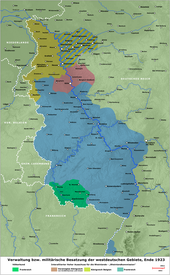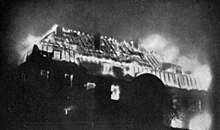Autonomous Palatinate
With Autonomous Palatinate attempts are called, after the First World War , the left-bank Pfalz as autonomous from Bavaria to establish an independent state. During the time of the French occupation after the First World War, separatist tendencies developed initially with the aim of an independent state in the Union of the German Reich , later also to create a state independent of the Reich and based on France.
Palatinate Republic
Eberhard Haass
In autumn 1918, the chemist Eberhard Haaß founded the "Bund Freie Pfalz" in Landau . Haaß was supported by the French general Augustin Grégoire Arthur Gérard . In May 1919 Haass asked the government president of the Palatinate, Theodor von Winterstein , to take over the leadership of the separatist movement. Since the latter refused, he was expelled from the Palatinate by the occupation authorities . Thereupon Haaß proclaimed the "Palatinate Republic" on June 1, 1919 and tried in vain to occupy the regional council in Speyer . The time for the putsch was extremely unfavorable, because a demonstration approved by the occupation authorities to remain in Bavaria was scheduled for the same day in Speyer, in which more than 10,000 people took part. A little later, when General Gérard was recalled, Haaß lost his most important supporter, and the “Bund Freie Pfalz” had failed.
Reactions from Bavaria
In order to fight separatism and to keep the connection to the Palatinate administration, the Bavarian government founded the central office for Palatinate affairs and the main auxiliary office for the Palatinate . Both had their headquarters initially in Mannheim and later in Heidelberg and were thus located just outside the French occupied territory. The institutions also took on part of the tasks of the legitimate Palatinate government, but the main objective was to defend against Palatinate separatism through press and propaganda publications , through contacting Palatine personalities and institutions and also by collecting intelligence information. At the same time the post of State Commissioner for the Palatinate was created in the Bavarian government . The first incumbent was von Winterstein, followed by Lorenz Wappes .
Autonomous Palatinate
causes
The Franco-Belgian occupation of the Ruhr since the spring of 1923 and the resulting economic problems, especially inflation , marked the beginning of the second phase of Palatinate separatism.
Johannes Hoffmann
In October 1923 it was initially a few Palatine Social Democrats under Johannes Hoffmann who - supported by the commander of the French occupying power, General Adalbert François Alexandre de Metz - wanted to create an independent Palatinate state in the Association of the German Empire, until they encountered resistance from authorities and parties - especially Hoffmann's Social Democrats refused to join forces - failed.
Franz Josef Heinz (Heinz-Orbis)
In contrast, Franz Josef Heinz (Heinz-Orbis) pursued much more radical goals: the creation of a state that was independent of the Reich and based on France. With the help of his "Palatinate Corps" he gained control of the Palatinate cities of Kaiserslautern , Neustadt an der Haardt and Landau between October 6 and 10, 1923 . After the capitulation of the government of the Palatinate , Heinz proclaimed the Autonomous Palatinate in Speyer on November 12, 1923, as part of the Association of the Rhenish Republic . In the next few weeks, the separatists fell to more and more Palatinate cities, such as Edenkoben on the night of November 18.
Apparently with the approval of the Bavarian government , Heinz and his closest followers (including Nikolaus Fußhöller) were murdered on January 9, 1924 in the guest room of the Speyer hotel "Wittelsbacher Hof" by members of the Wiking Association . In the evening, under the command of Edgar Julius Jung, around 20 men who had come across the frozen Rhine stormed the dining room in the "Wittelsbacher Hof". The assassins shouted: "Hands up, it's only for the separatists!" And immediately shot the men eating together at a table. Matthias Sand, an acquaintance of Heinz Orbis, who sat with the Palatinate Autonomous, was also killed. The uninvolved business traveler Wilhelm Spankuß, who happened to be seated at the same table, lost two molar teeth as a result of a shot across his mouth. Two of the attackers, Franz Hellinger and Ferdinand Wiesmann , also died in the subsequent exchange of fire ; Jung was only slightly injured and fled the Palatinate to Munich.
After the deed, Heinz's previous deputy, Adolf Bley, the factory owner and city councilor from Kirchheimbolanden , formed a short-lived new government . The act ultimately meant the end of the separatists, who were never popular with the population because of their enforcement with criminals and their proximity to the French state, and because of financial problems and the fact that the civil servants remained loyal to the Bavarian government, never under the administration could get their actual control.
Under National Socialism, the public prosecutor classified the murders as a legal act of state emergency aid . Before that, in 1932, on the initiative of right-wing extremists sympathizers of the murderers, a memorial was erected on the two dead assassins in the Speyer cemetery . In Kaiserslautern a street was named after Ferdinand Wiesmann, but it was later given back its old name Schwanenstraße .
Storming of the Pirmasens district office
The final point for the Autonomous Palatinate was set with the assault on the Pirmasens district office on February 12, 1924 - favored by the French troops by initially not intervening . All sixteen separatists present in the district office - which was set on fire before the storming - who had answered a crowd's demand for freedom of the press to be restored with gunshots and hand grenades , fell during the storming of the house or were subsequently lynched ; six of the attackers were killed and twelve seriously injured.
End of the "Autonomous Palatinate"
Politically, the end of the “Autonomous Palatinate” was largely resolved beforehand. The relationship between the German Reich and France had improved significantly in early 1924 with the conclusion of the MICUM Agreement . In addition, on January 11, 1924, the Speyer bishop Ludwig Sebastian and the church president of the Protestant Church of the Palatinate, Karl Heinrich Fleischmann (1867–1954), spoke out against recognition of the “Autonomous Palatinate”.
As early as November 1923, Lord Kilmarnock (1876–1928), British High Commissioner at the Inter-Allied Rhineland Commission , suggested that his government investigate the situation. This suggestion has now been taken up by the British government, on whose behalf Robert Henry Clive (1877–1948), British Consul General in Munich, traveled to the Palatinate from January 14th to 18th, 1924. Clive stated that the majority of the population reject the separatist government, which has no government experience and can only survive with French help.
In response to this report, Great Britain succeeded in setting up a committee of inquiry of the inter-allied Rhineland Commission , which negotiated the Speyer Agreement with the district committee of the Palatinate from February 14th to 16th . This agreement regulates the withdrawal of the separatists and the transfer of administration to the (Bavarian) district government.
literature
- Gerhard Gräber, Matthias Spindler : The Palatinate Liberators: People's Wrath and State Power in the Armed Struggle Against Palatinate Separatism 1923/24 . Pro Message, Ludwigshafen / Rhein 2005, ISBN 3-934845-24-X (including about the murder of Franz Josef Heinz and the storming of the Pirmasens district office in 1924)
- Wilhelm Kreutz, Karl Scherer (ed.): The Palatinate under French occupation (1918 / 19–1930) . Institute for Palatinate History and Folklore , Kaiserslautern 1999, ISBN 3-927754-24-2 .
- Ferdinand Schlickel : Location of Palatine history: The Wittelsbacher Hof. Shots in the dining room 50 years ago . In: " The Rheinpfalz - Speyerer Rundschau", five-part series, beginning on January 8, 1994.
- Gerhard graves, Matthias Spindler: Revolver republic on the Rhine. The Palatinate and its Separatists , Volume 1: November 1918 - November 1923. Pfälzische Verlags-Anstalt, Landau / Pfalz 1992, ISBN 3-87629-164-X .
- Documents from the liberation struggle in the Palatinate . Publishing house Pfälzische Rundschau, Ludwigshafen 1930.
- From the occupation in Speyer, 1918–1930 . Speyer City Archives, Speyer 1940.
- Bavarian State Commissioner for the Palatinate (ed.): The Palatinate under French occupation from 1918 to 1930: calendar representation of the events from the invasion in November 1918 to the evacuation on July 1, 1930 . "Süddeutsche Monatshefte", Munich 1930.
Web links
- Helmut Gembries: Autonomous Palatinate, 1923/24 . In: Historical Lexicon of Bavaria
- Gerhard graves: Palatine separatism . In: Historical Lexicon of Bavaria
- Struggle for the Republic 1919–1923: Separatism
- Separation time in Altrip
- Celia Applegate: A Nation of Provincials: The German Idea of Heimat . Berkeley: University of California Press ( English )
- National Socialism, Occupation of the Rhineland, and Rhenish separatism
Individual evidence
- ↑ Lorenz Wappes' curriculum vitae.
- ↑ Holger Gembries, Historisches Lexikon Bayerns: Pfälzischer Corps
- ^ Wilhelm Kreutz / Karl Scherer: The Palatinate under French occupation , p. 191 ff.
- ↑ Homepage Historischer Verein Speyer, January 25, 2014: Monument commemorates an attack. A stone reminder of the separatist leader's murder on January 9, 1924
- ↑ Tanja Breitenbach, Mainpost, January 18, 2006: Right-wing extremist assassin or freedom fighter?
- ↑ Old City Views, Album 19, Old District Office. Archived from the original on December 29, 2016 ; Retrieved on December 28, 2018 (photo with what was then Ferdinand-Wiesmann-Strasse, before and later again Schwanenstrasse).
- ↑ On Karl Heinrich Fleischmann see Friedhelm Hans: FLEISCHMANN, Karl Heinrich. In: Biographisch-Bibliographisches Kirchenlexikon (BBKL). Volume 31, Bautz, Nordhausen 2010, ISBN 978-3-88309-544-8 , Sp. 454-456. ; Friedhelm Hans: Karl Heinrich Fleischmann (1867–1954). Consistorial director and Palatine church president. In: Sheets for Palatine church history and religious folklore . Volume 70, 2003, pp. 123-169.
- ^ Robert Henry Clive on thepeerage.com , accessed August 19, 2015..




